Growth Trends Shaping India's Ocean Freight Market in 2025
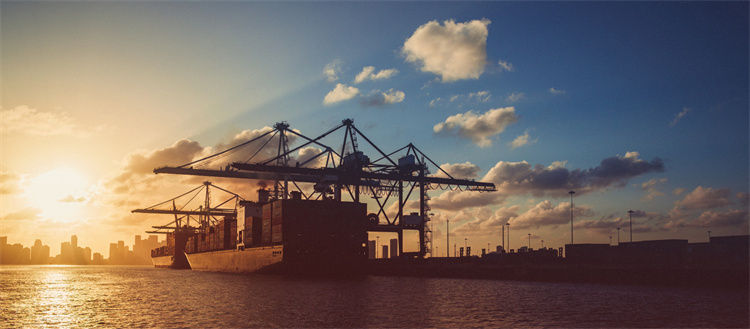
India’s ocean freight market in 2025 is undergoing rapid transformation. You can expect rising trade volumes, advanced technology, and green shipping initiatives to reshape how goods move across seas. These changes bring new opportunities for businesses to grow and thrive. However, staying ahead requires you to adapt quickly. By understanding these shifts, you can position your business for success and contribute to a stronger economy. The ocean freight market in India is not just evolving—it’s creating a dynamic space for innovation and progress.
Key Takeaways
More goods being shipped shows higher need for ocean transport. Companies should adjust to this to grow worldwide connections.
Improving ports and building better infrastructure makes shipping faster. Businesses can use government plans like the Sagarmala Program.
Using eco-friendly shipping helps meet green goals. It lowers harm to nature and attracts customers who care about the planet.
Using smart tools like AI and blockchain makes shipping smoother. These tools give live updates and make operations clearer.
Finding new trade paths and markets reduces risks from global issues. Having more trade choices helps businesses grow and stay strong.
Key Growth Drivers in the Ocean Freight Market in India
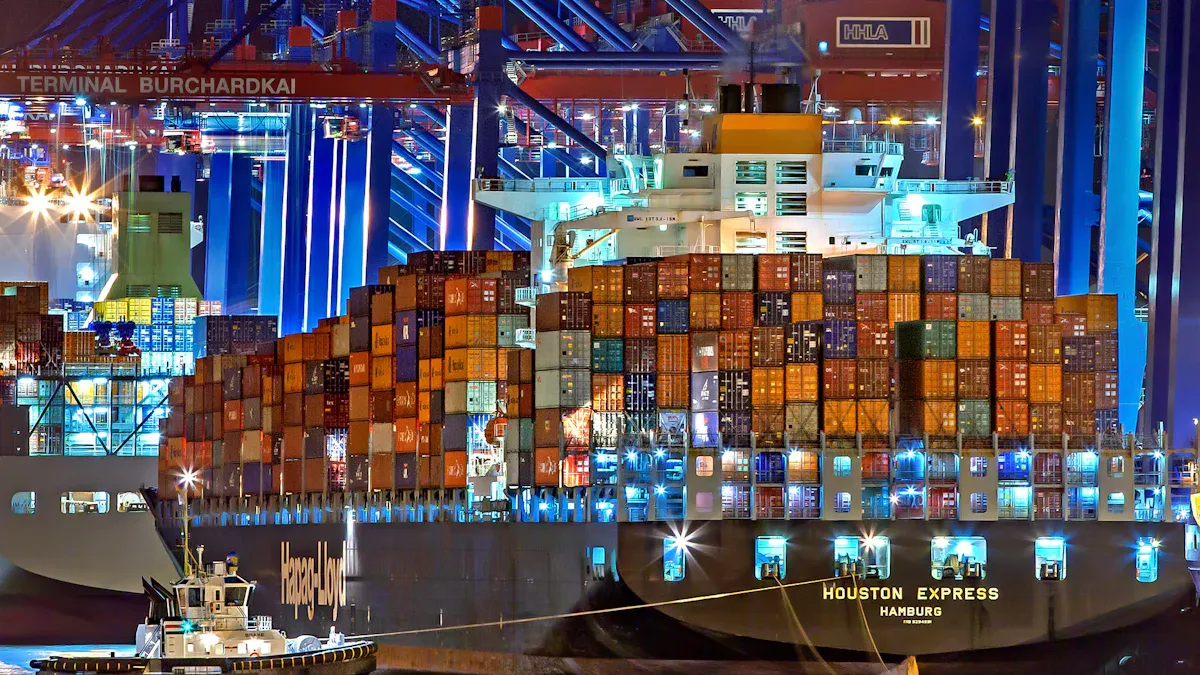
Rising Cargo Volumes and Trade Expansion
India's ocean freight market in 2025 is witnessing a surge in cargo volumes, reflecting the country's growing trade activities. You can see this in the numbers: in FY24, the 12 major ports in India handled 819.227 million tonnes of cargo, marking a 4.45% increase from the previous year. This growth highlights the rising demand for maritime transport as businesses expand their global reach.
The maritime sector plays a vital role in India's economy. It manages 95% of the country's international trade volume and accounts for 70% of export values. With plans to expand port capacity by 500-550 million tonnes annually by FY2028, you can expect even greater efficiency in handling petroleum, coal, and containerized cargo. These developments position the ocean freight market in India as a cornerstone of the nation's trade infrastructure.
Port Modernization and Infrastructure Investments
Modernizing ports and improving infrastructure are key drivers of growth in India's maritime sector. The Sagarmala Programme, a flagship initiative, focuses on enhancing port capacity and reducing logistics costs. It aims to improve hinterland connectivity and streamline cargo movement. For example, the government is upgrading existing ports with advanced cargo handling systems and developing new ones to meet rising demand.
The National Infrastructure Pipeline (NIP) further supports these efforts. Launched in 2019, it targets infrastructure projects worth INR 102 lakh crores, with over US$1 trillion in funding planned over five years. This includes significant private sector involvement, ensuring faster implementation and innovation. These investments not only boost the ocean freight market in India but also create opportunities for businesses like yours to benefit from improved logistics efficiency.
Adoption of Green and Sustainable Shipping Practices
Sustainability is becoming a priority in India's maritime industry. Initiatives like the Harit Sagar Green Port Guidelines 2023 provide a roadmap for eco-friendly port operations. These guidelines promote renewable energy sources, such as solar and wind, and encourage the development of green fuel infrastructure for hydrogen and ammonia.
Initiative | Description |
|---|---|
Harit Sagar Green Port Guidelines 2023 | A strategic roadmap for sustainable port operations. |
Emphasis on Green Energy | Promotes solar and wind energy for port operations. |
Green Tug Transition Program | Converts tugboats to non-fossil fuels. |
Waste Management and Water Conservation | Implements eco-friendly waste and water practices. |
Ports like V.O. Chidambaranar (Tuticorin) and Jawaharlal Nehru Port Trust (JNPT) are leading the way. They have adopted solar and wind power initiatives, along with shore power systems, to reduce emissions. By embracing these practices, you can align your business with global sustainability goals while contributing to a greener future for the ocean freight market in India.
Government Policies Boosting Maritime Trade
India's government has implemented several policies to strengthen maritime trade and enhance the ocean freight market in India. These initiatives aim to improve efficiency, reduce costs, and expand trade opportunities. By leveraging these policies, you can benefit from a more robust and streamlined maritime ecosystem.
One of the most impactful policies is the Sagarmala Programme. This initiative focuses on port-led development, aiming to reduce logistics costs and improve connectivity between ports and hinterlands. It includes projects for modernizing ports, developing coastal economic zones, and enhancing inland waterways. These efforts create a seamless flow of goods, enabling faster and more cost-effective trade.
The government also prioritizes energy security through maritime trade. India imports 80% of its crude oil requirements via sea routes, with daily imports reaching 3.28 million barrels. Additionally, 45% of LNG imports rely on maritime transport. These statistics highlight the critical role of ocean freight in meeting the country's energy needs.
Metric | Value |
|---|---|
Percentage of trade by volume via Indian Ocean | |
Percentage of trade by value via Indian Ocean | 68% |
Daily crude oil imports via sea | 3.28 million barrels |
Percentage of crude oil requirement imported by sea | 80% |
Sea dependence for oil (including offshore production) | 93% |
Percentage of LNG imports via sea | 45% |
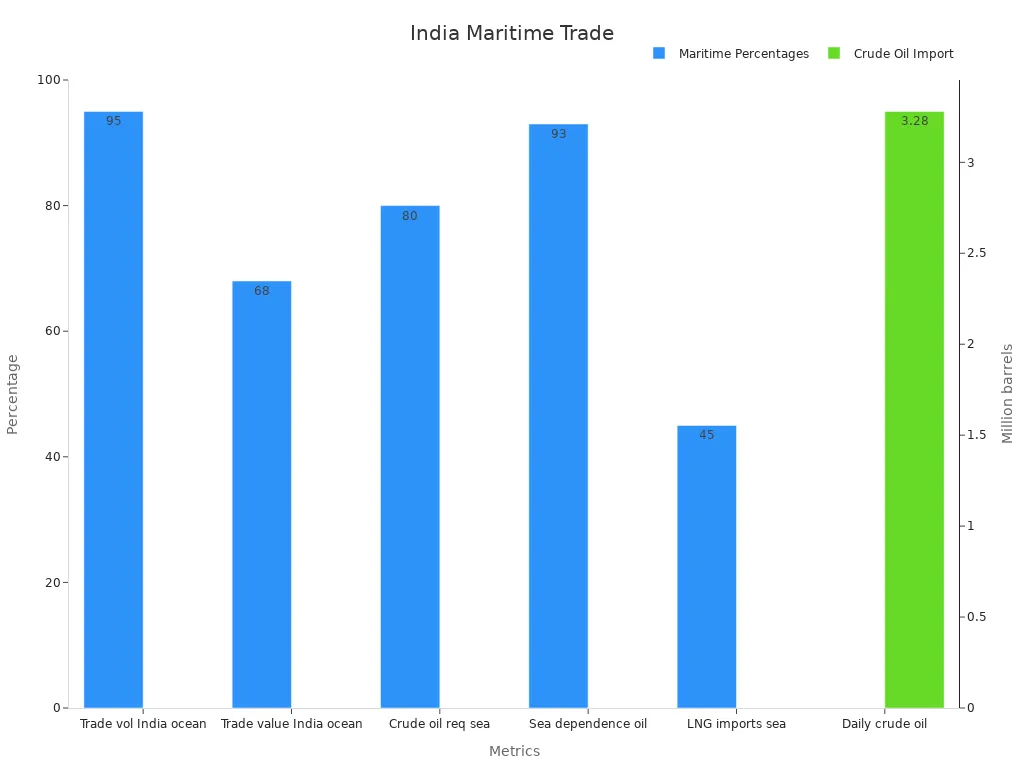
These policies not only boost trade volumes but also ensure the sustainability of India's energy supply chain. By aligning your business strategies with these initiatives, you can tap into the growing opportunities in the ocean freight market in India.
Technological Innovations in Logistics and Supply Chains
Technology is revolutionizing logistics and supply chains in India's maritime sector. Innovations like artificial intelligence (AI), the Internet of Things (IoT), and blockchain are transforming how goods are transported and managed. By adopting these technologies, you can improve efficiency, reduce costs, and enhance transparency.
AI and IoT integration provide real-time insights into cargo movement, enabling better decision-making. For example, optimized routing techniques minimize emissions and reduce transit times. Blockchain technology enhances transparency by creating secure and tamper-proof records of transactions, which is crucial for sustainable supply chains.
Technological Innovation Trend | Description |
|---|---|
Electric vehicles (EVs) | Adoption for cargo transportation |
Carbon-neutral shipping solutions | Initiatives to reduce carbon footprint |
Optimized routing | Techniques to minimize emissions |
AI and IoT integration | Real-time insights for better decision-making |
Blockchain technology | Enhances transparency in sustainable supply chains |
Strengthening cybersecurity | Measures to protect digital logistics operations |
Real-time insights through AI and IoT integration
Focus on cybersecurity with end-to-end encryption and multi-factor authentication
Data analytics for optimizing demand forecasting and inventory management
These innovations not only improve operational efficiency but also align with global sustainability goals. By embracing these technologies, you can position your business as a leader in the ocean freight market in India.
Future Outlook for the Ocean Freight Market in India
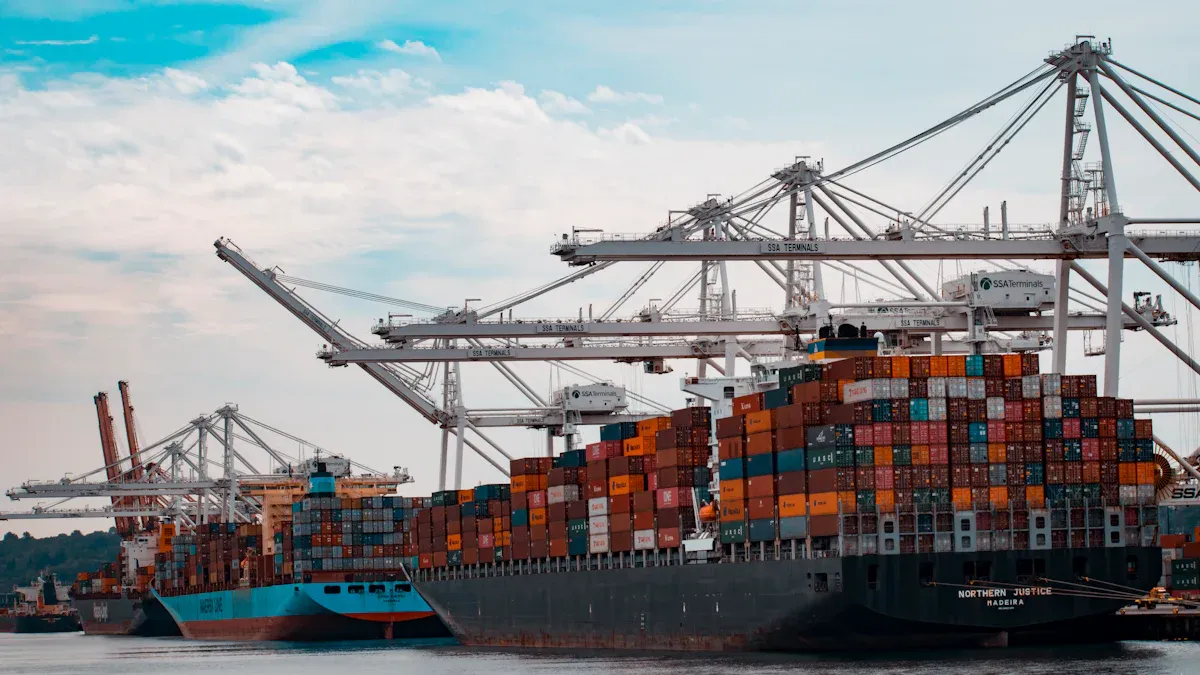
Opportunities for Fleet Expansion and Modernization
India's maritime sector is poised for significant fleet expansion and modernization. With the government allowing 100% Foreign Direct Investment (FDI) in port and harbor projects, you can expect a surge in private investments. This policy, combined with a 10-year tax holiday for port developers, creates a favorable environment for growth. The annual cargo-handling capacity has already increased from 871.52 million tonnes in 2014-15 to 1,629.86 million tonnes in 2023-24. This trend highlights the growing demand for advanced fleets to meet rising trade volumes.
Project Status | Investment (₹) |
|---|---|
Total Projects Planned | |
Completed Projects | ₹1.22 lakh crore |
Ongoing Projects | ₹1.8 lakh crore |
Projects in Development | ₹2.78 lakh crore |
Modernizing fleets with sustainable technologies, such as LNG-powered vessels, can help you stay competitive. These advancements not only reduce operational costs but also align with global sustainability goals. By investing in fleet upgrades, you can position your business to capitalize on the growing ocean freight market in India.
Growth of Smart Ports and Digitalized Operations
The rise of smart ports is transforming India's maritime landscape. Adani Ports, the largest private port operator, is leading the way by investing in automation and new port construction. These smart ports use advanced technologies like real-time data collection and performance monitoring to enhance efficiency. For example, automated cargo handling systems reduce turnaround times, allowing you to move goods faster and at lower costs.
Key Benefits of Smart Ports:
Increased port throughput and revenue.
Reduced maintenance costs through predictive analytics.
Enhanced supply chain visibility with digital tools.
These advancements make operations more efficient and sustainable. By leveraging smart port technologies, you can streamline your logistics and improve profitability.
Enhanced Trade Access Through Global Partnerships
Global partnerships are opening new avenues for India's maritime trade. The country has expanded its export portfolio to include 3,934 product lines to the U.S., with 360 high-potential products identified. These partnerships enhance trade access and create opportunities for you to explore new markets.
Statistic Description | Value |
|---|---|
Total product lines exported to the U.S. | 3,934 |
Product lines facing 10% tariff | 3,100 |
Product lines facing 25% tariff | 343 |
High-potential products identified | 360 |
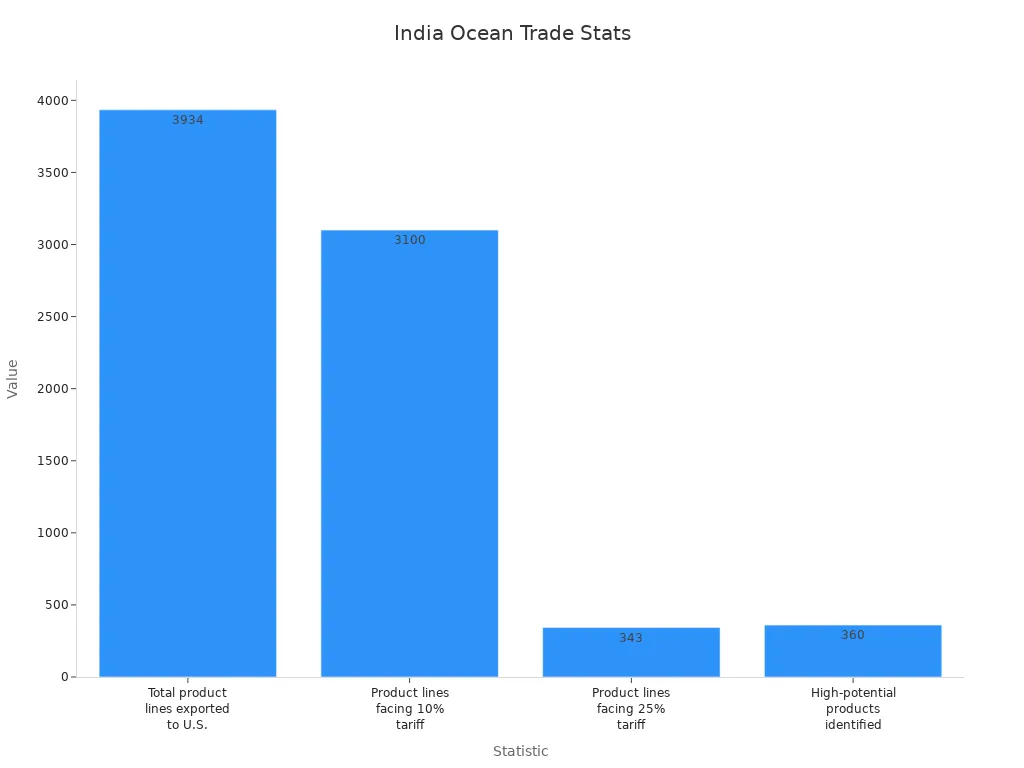
Collaborating with international stakeholders can help you diversify your trade routes and reduce dependency on traditional markets. This strategy not only mitigates risks but also ensures long-term growth in the ocean freight market in India.
Increasing Adoption of Multimodal Transportation
Multimodal transportation is transforming how goods move across India. By combining different modes of transport—such as road, rail, and waterways—you can achieve faster and more cost-effective logistics. This approach is gaining traction in the ocean freight market in India, driven by government initiatives and rising trade demands.
The market for multimodal transportation is expanding rapidly:
Market Size in 2024: USD 1.6 billion
Market Forecast in 2033: USD 6.5 billion
Market Growth Rate (2025–2033): 16.50%
To support this growth, the government has introduced several projects:
Creation of a Logistics Division in the Department of Commerce to streamline operations.
Development of 35 Multimodal Logistics Parks (MMLPs) under the Bharatmala Pariyojana.
Enhanced port connectivity through Sagarmala and inland waterways with new terminals.
These efforts aim to reduce transit times and costs while improving supply chain efficiency. For example, multimodal logistics parks integrate warehousing, cargo handling, and transportation services in one location. This setup allows you to switch between transport modes seamlessly, ensuring smoother operations.
By adopting multimodal transportation, you can optimize your logistics strategy and stay competitive in a fast-evolving market.
Role of Private Investments in Driving Innovation
Private investments are playing a pivotal role in modernizing India's maritime sector. As a business owner, you can benefit from the innovations these investments bring, such as advanced port infrastructure and digitalized operations.
India has emerged as a leader in "soft investments," focusing on technology and services rather than physical assets. The following table highlights how India compares to other countries in investment strategies:
Country | Investment Class | Notes |
|---|---|---|
India | Soft class | |
China | Hard class | Focuses on physical infrastructure |
Sweden | Hard class | Predominantly hard investments |
Singapore | Soft class | Similar to India in investment strategy |
Norway | Mixed investments | Balances hard and soft investments |
Private players are also driving innovation through automation and green technologies. For instance, Adani Ports has invested heavily in smart port systems, enabling real-time cargo tracking and predictive maintenance. These advancements reduce operational costs and improve efficiency.
By aligning your business with private sector innovations, you can leverage cutting-edge solutions to enhance your operations. Whether it's adopting digital tools or collaborating with private stakeholders, these investments offer you a pathway to growth in the ocean freight market in India.
Strategies for Businesses to Adapt to Market Trends
Leveraging Technology for Supply Chain Efficiency
Adopting technology can transform your supply chain operations, making them more efficient and resilient. India’s National e-Governance Division, in collaboration with the Indian Ports Association, is bridging digital gaps in the maritime sector. This initiative focuses on advanced software development, system integration, and emerging technologies to optimize logistics systems. By leveraging these advancements, you can streamline operations and reduce costs.
Digital transformation also facilitates better data exchange among stakeholders. A World Bank report highlights how digital ecosystems improve supply chain efficiency and safety. For example:
Advanced technologies like AI and IoT provide real-time insights into cargo movement.
Blockchain ensures secure and transparent transactions.
Predictive analytics helps you anticipate disruptions and plan accordingly.
These tools not only enhance operational efficiency but also contribute to a sustainable recovery in the maritime industry. Embracing digitalization positions your business as a leader in the evolving ocean freight market in India.
Building Resilience Against Geopolitical Risks
Geopolitical tensions can disrupt trade routes and supply chains, but you can mitigate these risks with proactive strategies. Companies like Apple have diversified their manufacturing bases to India and Vietnam, reducing exposure to tariffs and export restrictions. You can follow a similar approach by exploring alternative trade corridors and sourcing options.
Investing in technology and automation further strengthens your resilience. AI and predictive analytics allow you to assess potential disruptions and optimize supply chains. Building strategic inventory buffers can also cushion against supply delays. Collaborating with industry peers to share resources during crises ensures smoother operations.
A vulnerability matrix can help you evaluate risks based on trade exposure and GDP dependency. By prioritizing infrastructure investments and diversifying trade routes, you can safeguard your business against geopolitical uncertainties.
Investing in Sustainable Shipping Solutions
Sustainability is no longer optional—it’s a necessity. Transitioning to green shipping practices can reduce your environmental impact and align your business with global standards. Initiatives like the Harit Sagar Green Port Guidelines encourage the use of renewable energy and low-emission fuels.
You can invest in technologies like LNG-powered vessels or hybrid engines to meet stricter environmental regulations. Retrofitting existing fleets with scrubbers ensures compliance with IMO 2020 sulfur emission limits. These measures not only reduce operational costs but also attract eco-conscious clients.
By adopting sustainable solutions, you contribute to a greener future while staying competitive in the global market.
Collaborating with Public and Private Stakeholders
Collaboration between public and private stakeholders plays a critical role in shaping the future of the ocean freight market in India. By working together, these entities can address challenges, improve infrastructure, and unlock new growth opportunities. You can benefit from these partnerships by aligning your business strategies with ongoing initiatives.
Public-private partnerships (PPPs) have already proven effective in modernizing India's ports. For example, the Jawaharlal Nehru Port Trust (JNPT) has partnered with private players to enhance cargo handling capacity and reduce turnaround times. These collaborations bring in advanced technologies and expertise, which improve operational efficiency.
You can also engage with government programs like the Sagarmala initiative. This program encourages private investments in port development, coastal economic zones, and multimodal logistics parks. By participating in such projects, you can gain access to better facilities and streamlined supply chains.
Tip: Building relationships with both public and private stakeholders can help you stay informed about upcoming projects and policy changes. This knowledge allows you to adapt quickly and seize new opportunities.
Exploring New Trade Routes and Market Opportunities
Exploring new trade routes and markets is essential for staying competitive in the evolving ocean freight market in India. Diversifying your trade routes reduces dependency on traditional shipping lanes and minimizes risks from disruptions like geopolitical tensions or port congestion.
India's strategic location offers access to emerging markets in Southeast Asia, Africa, and the Middle East. You can leverage initiatives like the India-Middle East-Europe Economic Corridor (IMEC) to expand your reach. This corridor aims to enhance connectivity and reduce transit times, creating new opportunities for exporters and importers.
Additionally, free trade agreements (FTAs) with countries like Australia and the UAE open doors to untapped markets. These agreements lower tariffs and simplify trade processes, making it easier for you to explore new business opportunities.
Trade Route | Key Benefits |
|---|---|
India-Middle East-Europe Economic Corridor | Faster transit and reduced costs |
Southeast Asia Routes | Access to high-growth markets |
Africa Connections | Opportunities in raw materials and goods |
Note: Regularly analyzing market trends and trade policies can help you identify high-potential routes and regions. This proactive approach ensures your business stays ahead of the competition.
The ocean freight market in India is evolving rapidly, driven by rising trade volumes, technological advancements, and sustainable practices. These trends create opportunities for you to optimize operations and expand into new markets. Adopting proactive strategies like leveraging technology and exploring alternative trade routes ensures your business stays competitive. With ongoing investments and global partnerships, the future of India's maritime sector looks promising. By aligning with these growth trends, you can contribute to a thriving economy and secure long-term success.
FAQ
1. How can you benefit from adopting green shipping practices?
Green shipping practices reduce your carbon footprint and operational costs. They also align your business with global sustainability goals, attracting eco-conscious clients. By investing in renewable energy and low-emission technologies, you contribute to a cleaner environment while staying competitive in the market.
2. What is the role of the Sagarmala Programme in India's maritime sector?
The Sagarmala Programme focuses on port-led development. It improves port infrastructure, enhances connectivity, and reduces logistics costs. By aligning your business with this initiative, you can benefit from streamlined operations and better access to domestic and international markets.
3. Why is multimodal transportation important for your business?
Multimodal transportation combines road, rail, and waterways to optimize logistics. It reduces transit times and costs while improving supply chain efficiency. By adopting this approach, you can ensure faster deliveries and seamless cargo movement, giving your business a competitive edge.
4. How do technological innovations improve supply chain efficiency?
Technologies like AI, IoT, and blockchain provide real-time insights, enhance transparency, and optimize operations. For example, predictive analytics helps you anticipate disruptions, while blockchain ensures secure transactions. These tools streamline your supply chain, reduce costs, and improve decision-making.
5. What strategies can help you mitigate geopolitical risks?
Diversify trade routes and sourcing options to reduce dependency on unstable regions. Use predictive analytics to assess risks and build inventory buffers. Collaborate with industry peers to share resources during crises. These strategies strengthen your resilience against geopolitical disruptions.
See Also
Exploring 2024's Innovations in Sea Freight Logistics
Five Key Trends Shaping Future Supply Chain Efficiency
Understanding Current Trends in Logistics Risk Management
